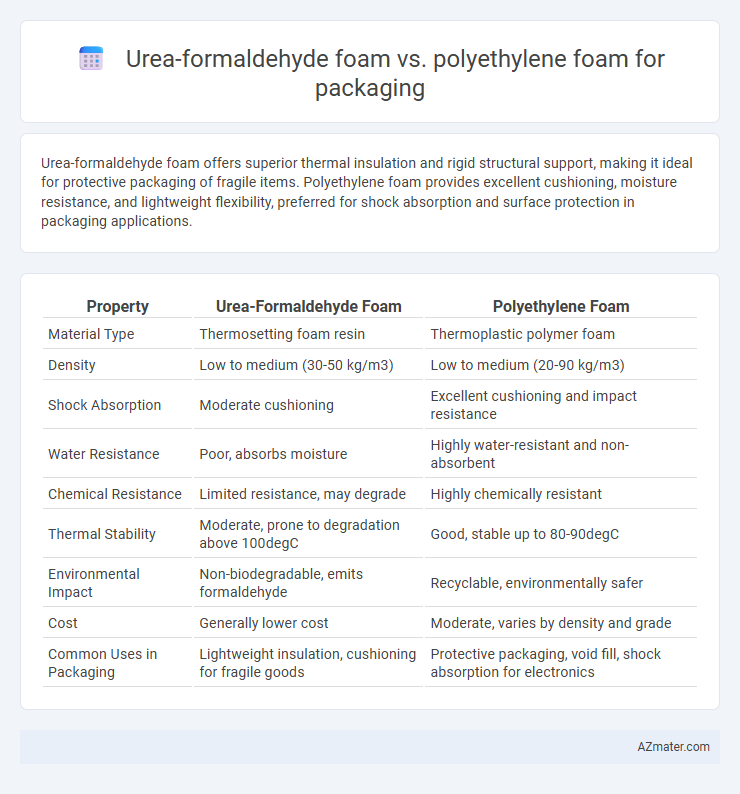Urea-formaldehyde foam offers superior thermal insulation and rigid structural support, making it ideal for protective packaging of fragile items. Polyethylene foam provides excellent cushioning, moisture resistance, and lightweight flexibility, preferred for shock absorption and surface protection in packaging applications.
Table of Comparison
| Property | Urea-Formaldehyde Foam | Polyethylene Foam |
|---|---|---|
| Material Type | Thermosetting foam resin | Thermoplastic polymer foam |
| Density | Low to medium (30-50 kg/m3) | Low to medium (20-90 kg/m3) |
| Shock Absorption | Moderate cushioning | Excellent cushioning and impact resistance |
| Water Resistance | Poor, absorbs moisture | Highly water-resistant and non-absorbent |
| Chemical Resistance | Limited resistance, may degrade | Highly chemically resistant |
| Thermal Stability | Moderate, prone to degradation above 100degC | Good, stable up to 80-90degC |
| Environmental Impact | Non-biodegradable, emits formaldehyde | Recyclable, environmentally safer |
| Cost | Generally lower cost | Moderate, varies by density and grade |
| Common Uses in Packaging | Lightweight insulation, cushioning for fragile goods | Protective packaging, void fill, shock absorption for electronics |
Introduction to Urea-Formaldehyde Foam and Polyethylene Foam
Urea-formaldehyde foam is a rigid, thermosetting resin-based material commonly used for insulation and packaging due to its excellent thermal stability and lightweight properties. Polyethylene foam, a flexible, closed-cell material derived from polymerized ethylene, is favored in packaging for its impact resistance, cushioning ability, and moisture resistance. Both foams serve distinct packaging purposes, with urea-formaldehyde foam offering structural rigidity and polyethylene foam providing protective cushioning.
Chemical Composition and Properties Comparison
Urea-formaldehyde foam consists primarily of a polymerized resin derived from urea and formaldehyde, offering rigid, thermosetting properties that provide excellent insulation and moisture resistance, but it is brittle and less flexible. Polyethylene foam is composed of polymerized ethylene units, resulting in a flexible, closed-cell structure with superior cushioning, chemical inertness, and moisture resistance, making it ideal for impact protection in packaging. The rigid, brittle nature of urea-formaldehyde limits its shock absorption capabilities compared to the pliable, resilient polyethylene foam widely used for protective packaging applications.
Key Applications in Packaging Industries
Urea-formaldehyde foam is primarily used for rigid packaging applications requiring high thermal insulation and structural support, such as in electronic and appliance casings. Polyethylene foam offers superior cushioning and impact resistance, making it ideal for protective packaging of delicate items like glassware, electronics, and consumer goods. Both materials serve essential roles, with urea-formaldehyde foam favored for insulation and structural integrity, while polyethylene foam excels in shock absorption and lightweight protection.
Cushioning Performance and Shock Absorption
Urea-formaldehyde foam offers excellent rigidity and thermal insulation but falls short in cushioning performance compared to polyethylene foam, which provides superior flexibility and impact resistance. Polyethylene foam's closed-cell structure enhances shock absorption, making it ideal for protecting delicate items during transit. In contrast, urea-formaldehyde foam is more brittle and prone to cracking under impact, limiting its effectiveness for packaging applications requiring high cushioning and shock absorption.
Moisture Resistance and Durability
Polyethylene foam offers superior moisture resistance compared to urea-formaldehyde foam, making it ideal for packaging applications exposed to humid or wet environments. Its closed-cell structure prevents water absorption, enhancing the longevity and protection of packaged goods. Urea-formaldehyde foam, while effective for insulation, tends to absorb moisture faster and is less durable under prolonged exposure to damp conditions.
Environmental Impact and Sustainability
Urea-formaldehyde foam releases formaldehyde gas, a known carcinogen, posing environmental and health risks during production and disposal, whereas polyethylene foam is chemically inert but contributes significantly to plastic pollution due to its non-biodegradability. Polyethylene foam can be recycled, though recycling infrastructure is limited, while urea-formaldehyde foam degrades slowly and may release hazardous substances as it breaks down. Sustainable packaging trends favor polyethylene foam with enhanced recyclability and the development of bio-based alternatives, aiming to reduce carbon footprint and landfill accumulation.
Cost Analysis and Economic Considerations
Urea-formaldehyde foam offers a lower initial material cost compared to polyethylene foam, making it attractive for budget-sensitive packaging applications. However, polyethylene foam's superior durability and resistance to moisture reduce long-term replacement expenses and potential product damage costs. Evaluating total cost of ownership reveals polyethylene foam may provide greater economic value despite higher upfront investment.
Safety, Health, and Regulatory Compliance
Urea-formaldehyde foam releases formaldehyde gas, posing significant health risks such as respiratory irritation and potential carcinogenic effects, which restrict its use under strict regulatory frameworks like OSHA and EPA standards. Polyethylene foam is generally safer, as it is chemically inert, non-toxic, and complies with FDA and REACH regulations for packaging applications. Selecting polyethylene foam enhances workplace safety and aligns with global health regulations, reducing liability and exposure to hazardous emissions.
Ease of Customization and Processing
Urea-formaldehyde foam offers limited customization due to its rigid structure and more complex processing requirements, making it less adaptable for varied packaging shapes. Polyethylene foam provides superior ease of customization with its flexible, moldable nature and straightforward extrusion and molding processes, allowing for precise tailoring to product dimensions. Processing polyethylene foam is generally faster and less energy-intensive, enhancing production efficiency in packaging applications.
Final Recommendation: Choosing the Right Foam for Packaging
Polyethylene foam offers superior moisture resistance, cushioning, and durability, making it ideal for protecting delicate electronics and heavy items during shipping. Urea-formaldehyde foam, while cost-effective and good for insulation, lacks the flexibility and impact absorption needed for most packaging applications. For final recommendations, polyethylene foam is the preferred choice in packaging due to its long-term reliability and versatility in safeguarding products.

Infographic: Urea-formaldehyde foam vs Polyethylene foam for Packaging
 azmater.com
azmater.com